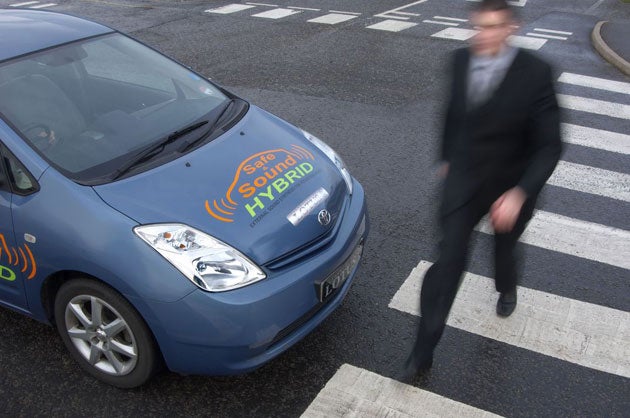Introducing the hybrid you can hear (so it won't run you over)

Your support helps us to tell the story
From reproductive rights to climate change to Big Tech, The Independent is on the ground when the story is developing. Whether it's investigating the financials of Elon Musk's pro-Trump PAC or producing our latest documentary, 'The A Word', which shines a light on the American women fighting for reproductive rights, we know how important it is to parse out the facts from the messaging.
At such a critical moment in US history, we need reporters on the ground. Your donation allows us to keep sending journalists to speak to both sides of the story.
The Independent is trusted by Americans across the entire political spectrum. And unlike many other quality news outlets, we choose not to lock Americans out of our reporting and analysis with paywalls. We believe quality journalism should be available to everyone, paid for by those who can afford it.
Your support makes all the difference.The fearsome roar of their engines is one of the first things to come to mind at the mention of Lotus, the stylish, lightweight British sports cars.
That familiar growl could soon be heard coming from a far more modest source: beneath the hitherto tranquil bonnets of other manufacturers' electric cars.
Lotus is developing technology that will put the roar of the traditional combustion engine under the hoods of eco-friendly vehicles, in an attempt to make the quiet cars safer for unsuspecting pedestrians – particularly the blind – and cyclists.
Stealthy hybrids and electric cars have come in for criticism from groups representing the blind and partially sighted, concerned that the low hum of the vehicles puts those with imperfect sight at greater risk of being hit on the roads. Some are almost silent at slow speeds.
Lotus said its "safe and sound hybrid technology" simulates the traditional grunt of a combustion engine, making it "instantly recognisable that the vehicle is in motion".
It has already put the system into a Toyota Prius, one of the most popular hybrid cars on the market. The device kicks in automatically to produce an artificial engine noise when the hybrid car runs on its electric motor. When the car's combustion engine takes over, sensors fitted to the engine and suspension turn off the sound.
The engine noise is produced by a waterproof loudspeaker positioned next to the car's radiator, making the sound seem to originate from under the bonnet. The system produces a pitch and frequency designed to help pedestrians identify the car's speed and distance.
Lotus adapted the system from technology previously developed to block outside noise from the inside of its cars.
Electric vehicles are tipped to become a more common sight on the roads over the coming decade as drivers seek ways of minmising the cost of ever-higher petrol prices and the issue of global warming moves up the agenda.
Mike Kimberley, chief executive of Group Lotus, said: "The increased acceptance of greener vehicles such as hybrid and electric vehicles is to be encouraged; they have an important role in improving fuel economy and reducing emissions. Our technology increases pedestrian safety, while retaining the car's environmental benefits."
Duncan Vernon, road safety manager for the Royal Society for the Prevention of Accidents, said: "We need to look at ways of ensuring the safety of pedestrians. We welcome innovative solutions which address this."
Lotus hopes that manufacturers of electric and hybrid cars will adopt the technology, which it says can also be fitted to cars already on the roads for a sum that would not "break the bank".
Pressure is growing on the Government to introduce minimum noise requirements for road vehicles, to ensure the noise-augmenting technology is used and that the new wave of quiet eco-friendly cars poses no risk to vulnerable pedestrians.
Clive Wood, transport policy officer at the Guide Dogs for the Blind Association, said: "Blind and partially sighted people use the noise of oncoming traffic as a cue for when it is safe to cross a road. If a quiet hybrid electric vehicle is approaching, then they will no longer have this cue and are immediately put at risk."
He added: "We recognise the environmental benefits of these vehicles. However, more consideration needs to be given to the safety implications to visually impaired pedestrians."
Silent danger on the street
*Electric and hybrid cars are so quiet many fear they pose a risk to pedestrians. One US study found electric and hybrid cars moving slowly had to be 40 per cent closer to pedestrians than conventional vehicles before their location could be detected. They have no noisy pistons, internal explosions or fan belts which cause the roar we associate with the traditional car engine. Hybrids pose an added problem. For much of the time, they are powered by a combustion engine. But at low speeds, an electric motor takes over, making them very quiet. The new system from Lotus kicks in when sensors detect the electric motor is working.
Join our commenting forum
Join thought-provoking conversations, follow other Independent readers and see their replies
Comments